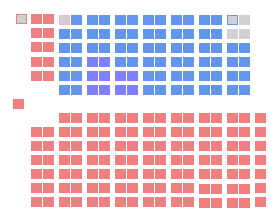November 7, 1900 | |||||||||||||||||||||||||||||||||||||
213 seats in the House of Commons 107 seats needed for a majority | |||||||||||||||||||||||||||||||||||||
|---|---|---|---|---|---|---|---|---|---|---|---|---|---|---|---|---|---|---|---|---|---|---|---|---|---|---|---|---|---|---|---|---|---|---|---|---|---|
| Turnout | 77.4% [1] ( | ||||||||||||||||||||||||||||||||||||
| |||||||||||||||||||||||||||||||||||||
 | |||||||||||||||||||||||||||||||||||||
 The Canadian parliament after the 1900 election | |||||||||||||||||||||||||||||||||||||
| |||||||||||||||||||||||||||||||||||||
The 1900 Canadian federal election was held on November 7, 1900, to elect members of the House of Commons of Canada of the 9th Parliament of Canada. As a result of the election, the Liberal Party, led by Prime Minister Wilfrid Laurier, was re-elected to a second majority government, defeating the Conservative Party and Liberal-Conservatives led by Charles Tupper.


